Auteur/autrice : C&A HD
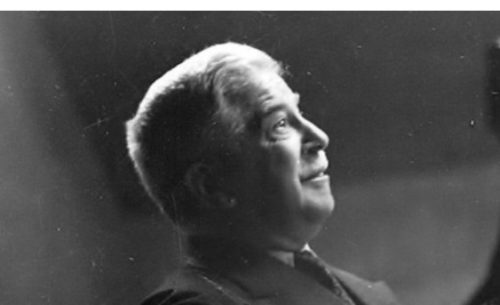
Sonate n°4 Op.7: 11 Novembre 1935; 15 Janvier1937 (face 2)
Sonate n°14 Op.27 n°2: 10& 11 Avril 1933
Sonate n°10 Op.14 n°2: 23 Avril 1934
Sonate n°29 Op.106 « Hammerklavier »: 3 & 4 Novembre 1935
Artur Schnabel, piano
London Abbey Road Studio n°3 – Engineer: Edward Fowler – piano: Bechstein
Source: disques 33 tours « The HMV Treasury »
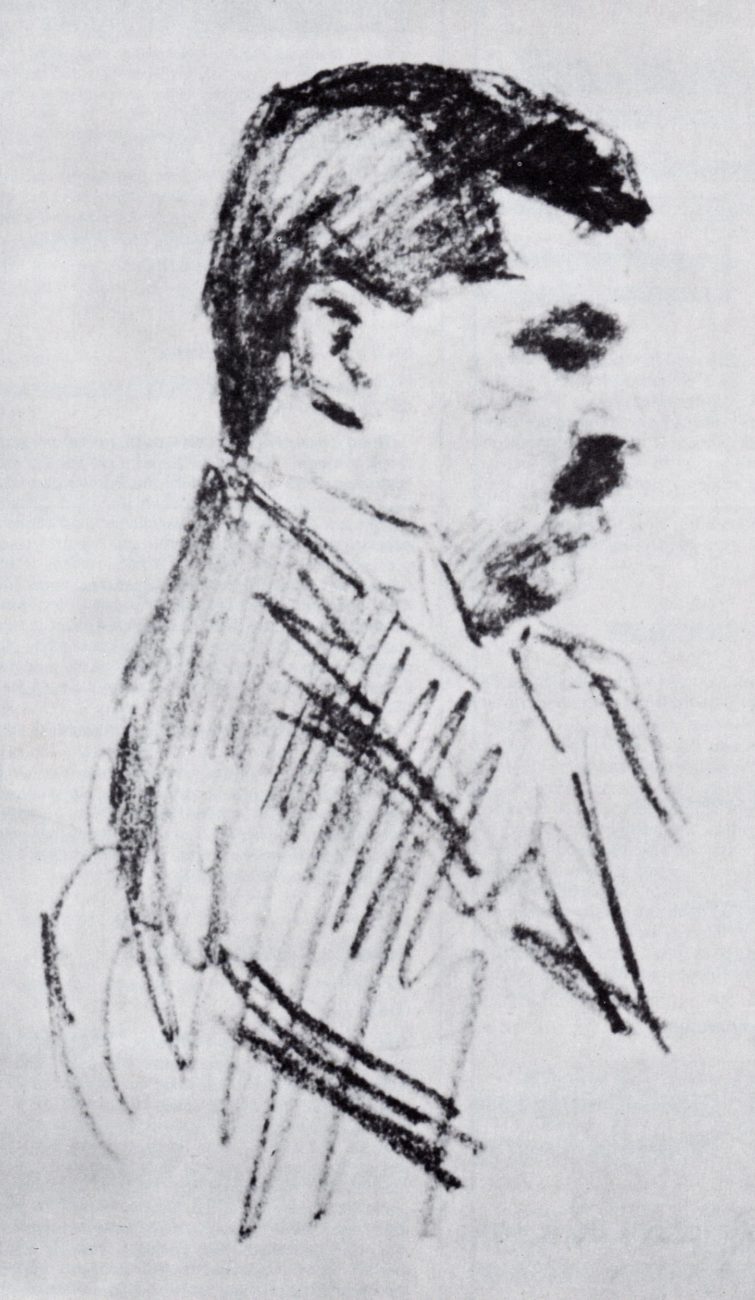
Les trois derniers récitals de l’intégrale des 32 sonates de Beethoven par Artur Schnabel en formaient le point culminant. En effet, ils se terminaient chacun par une des dernières sonates respectivement n°29 Op.106, n°30 Op.109 et enfin n°32 Op.111. La sonate n°31 Op.110 a quant à elle été jouée au cours du premier récital.
Pour plus de détails sur les sept récitals de cette intégrale, cliquer ICI
Le cinquième programme comportait les quatre sonates mentionnées ci-dessus, dont les deux premières ont été jouées en première partie de concert, alors qu’il aurait semblé plus logique de ne jouer que la sonate n°29 Op.106 en deuxième partie. On voit ici le souci de Schnabel d’individualiser au maximum chaque sonate en jouant en début de seconde partie la sonate n°10 Op.14 n°2 dont Eric Blom caractérisait le thème du premier mouvement en disant qu’il pourrait se chanter avec les paroles « O, what a happy day », tout en restant pour la monumentale sonate n°29 Op.106 dans le cadre stylistique qu’il s’était fixé: à un critique qui trouvait que son enregistrement de cette œuvre n’était pas du « grand piano », il a répliqué « it’s big in concept, not in sound » (c’est grand par le concept, et non par le son). Une grande leçon!
Comme les critiques de disque l’ont remarqué, l’Op.106 pose le problème des limites techniques de Schnabel à l’époque de l’enregistrement, d’autant plus qu’il se conforme aux indications métronomiques spécifiées par Beethoven (c’est la seule sonate pour laquelle le compositeur en a fourni). Claudio Arrau a dit que sa technique était parfaite jusqu’à l’arrivée au pouvoir des nazis, qui l’a contraint brutalement à quitter définitivement l’Allemagne, mais que c’est ensuite que les difficultés techniques sont apparues, de même que des trous de mémoire. Si ici, le début du premier mouvement est plutôt chaotique, il semble aussi qu’à la base, il y ait un choix conceptuel aussi génial que délibéré, comme si le discours, incroyablement tendu, émergeait du chaos pour s’organiser progressivement. Schnabel est celui qui ose! D’ailleurs, pour cette série d’enregistrements de novembre 1935, certaines des faces ont été refaites en janvier 1937 pour les sonates n°4 Op.7 & 16 Op.31 n°1, mais pas pour l’Op.106.
Peu après cet enregistrement, Schnabel a joué deux fois cette sonate, tout d’abord à Vienne au Konzerthaus (16 décembre 1935), puis à New-York le 12 avril 1936, le cinquième récital de son intégrale, et pour ces deux exécutions, les critiques ne mentionnent pas de problèmes techniques.
Pour le concert viennois, Herbert Peyser fait état d’un monumental récital Beethoven culminant dans une exécution de l’ ‘Hammerklavier’ apte à pulvériser quiconque aurait proféré des mots irrespectueux envers cet Opus prométhéen, notamment son apothéose fuguée.
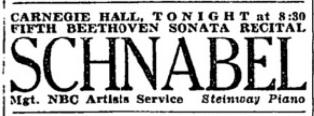
Pour le cinquième programme de l’intégrale donnée par Schnabel à Carnegie Hall en 1936, Howard Taubman mentionne que le couronnement de ce récital était l’interprétation de la sonate ‘Hammerklavier’ Op.106 (n°29), une éloquente re-création d’une oeuvre immense, et que les sonates joués avant semblaient pâles en comparaison. ‘L’ ‘Hammerklavier’ se situe sur le même plan que les pages gigantesques des symphonies de Beethoven. Même pour des oreilles modernes, elle sonne audacieuse de par son concept et d’une imagination brillante quant à son exécution, et plus d’un siècle s’est écoulé sans que son originalité prophétique en soit diminuée. Elle demande pour lui donner vie un pianiste qui maîtrise une fusion magistrale de la tête, du cœur et des mains, et Mr. Schnabel était hier soir un tel artiste. Il y avait de la passion et de la puissance dans les deux premiers mouvements de la sonate, et l’interminablement difficile section finale a été rendue avec une maîtrise achevée. Mais c’est dans l’immense mouvement lent – séraphique dans son exaltation et poignant par sa compassion interrogative – que Mr. Schnabel a joué de la manière la plus profondément émouvante de la soirée. Il n’y a à l’étranger pas beaucoup de pianistes capables de rendre justice à ce mouvement. Mr. Schnabel était en forme hier soir et son interprétation des trois sonates précédentes était marquée par une attention caractéristique à la fois pour les détails et pour la pleine conduite du discours d’une œuvre. La sonate en do dièse mineur (n°14 Op.27 n°2), depuis des années la préférée des broyeurs d’ivoire, y trouvait une nouvelle vitalité.’
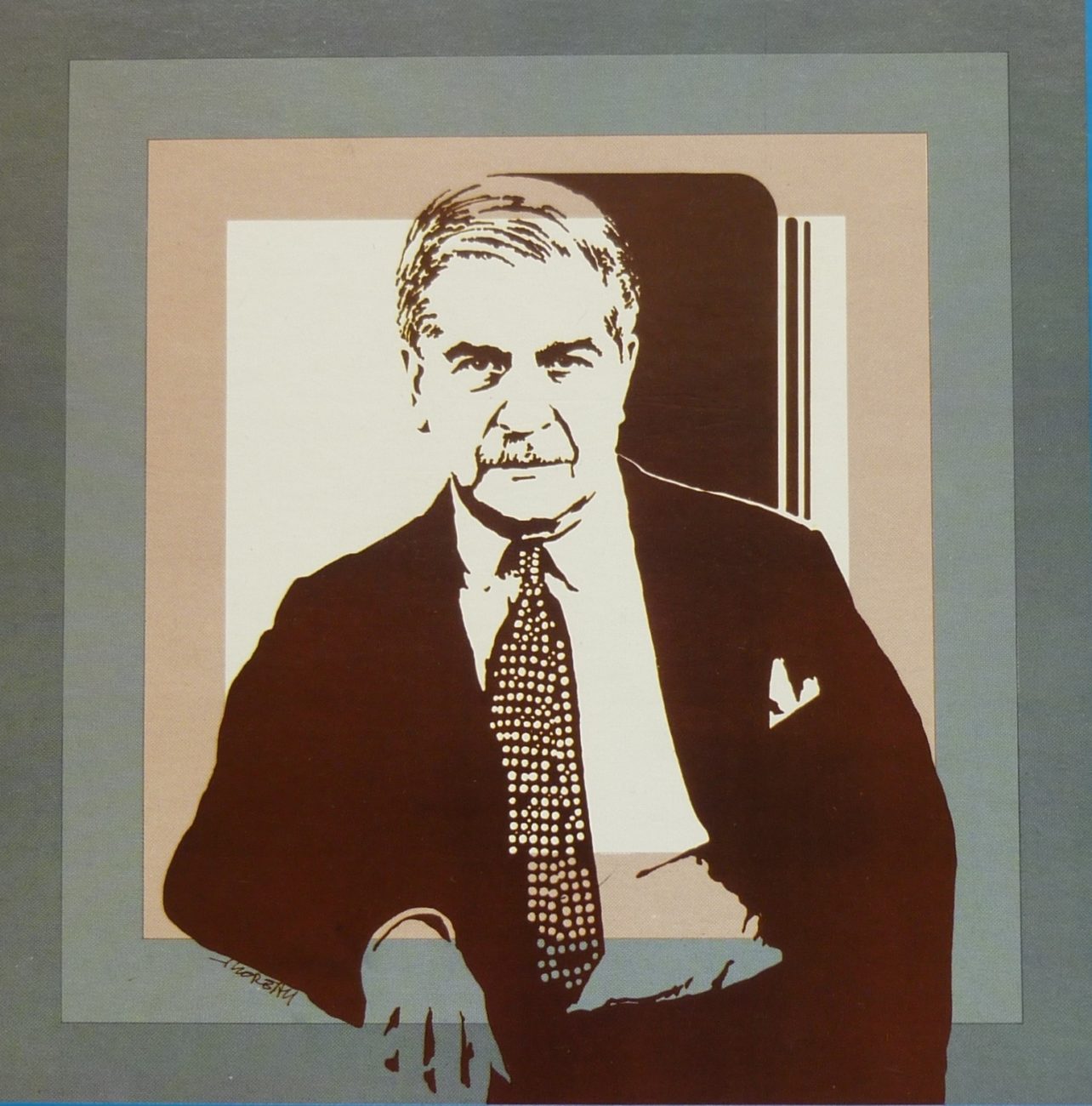
The last three recitals were the climax of Artur Schnabel’s complete performance of Beethoven’s 32 sonata. Indeed, each of them ended with one of the last sonatas respectively n°29 Op.106, n°30 Op.109 and finally n°32 Op.111. Sonata n°31 Op.110 was played separately at the first recital.
For a detailed description of the seven programs of his complete performances of Beethoven’s 32 sonatas, click HERE
The fifth program was comprised of the four above mentioned sonatas, the first two of which being played before the intermission, whereas it would have been more logical to play only the sonata n°29 Op.106 at the second part of the recital. This reflects Schnabel’s concern to individualize each sonata to the utmost by playing at the beginning of the second part the sonata n°10 Op.14 n°2 of which Eric Blom caracterized the thema of the first movement by saying it could be sung to the words « O, what a happy day », while remaining for the monumental sonata n°29 Op.106 in the stylistic frame he decided: to a critic objecting that his recording of this work was not « great piano », he replied « it’s big in concept, not in sound ». A great lesson!
As music critics have noticed, Op.106 poses the problem of Schnabel’s technical limits at the time of the recording, all the more so since he applies Beethoven’s metronomic markings (it is the only sonata for which the composer provided them). Claudio Arrau said that his technique was flawless until the nazis came to power, which brutally obliged him to leave Germany, but thereafter, technical difficulties started and also memory mistakes. If here the beginning of the first movement is rather chaotic, it seems also that basically this was a chosen concept as full of genius as it was deliberate, as if the incredibly tense musical flow emerged from chaos to organize itself progressively. Schnabel is the one who dares! Indeed for this series of recordings of November 1935, a few sides were re-recorded in January 1937 for the sonatas n°4 Op.7 & 16 Op.31 n°1 but not for Op.106!
Shortly after this recording, Schnabel performed this sonata twice, firstly at the Vienna Konzerthaus (16 December 1935), then on 12 April 1936, the fifth recital of his complete performance of the ’32s’, and in both cases, music critics do not mention at all technical problems.
For the Viennese concert, Herbert Peyser speaks of a monumental Beethoven recital culminating in a performance of the ‘Hammerklavier’ which must have pulverized any one who ever spoke a disrespectful word of this Promethean Opus, particularly of his fugal apotheosis.

For the fifth program of the complete performance given by Schnabel at Carnegie Hall in 1936, Howard Taubman mentions that the pinnacle of the recital was the performance of the B flat major Sonata Op.106 known as the ‘Hammerklavier’, an eloquent recreation of an immense work, and that the sonatas that had gone before seemed pale in comparison. ‘The ‘Hammerklavier’ is on the plane of the gigantic pages of Beethoven’s symphonies. Even to modern ears, it sounds audacious in design and brilliantly imaginative in execution; more than a century of currency has not dimmed its prophetic originality. It requires a pianist who commands a superb fusion of head, heart and hands to bring this sonata to life, and Mr. Schnabel was such an artist last night. There was passion, power and a broad line in the first two movements of the sonata, and the endlessly difficult final section was wrought with consumate ressource. But it was in the tremendous slow movement – seraphic in its exaltation and poignant in its searching compassion – that Mr. Schnabel did the most profoundly moving playing of the evening. There are no many pianists abroad who can do justice to this movement. Mr. Schnabel was in the vein last night and his interpretations of the three earlier sonatas were marked with a characteristic regard both for detail and the full sweep of a work. The C sharp minor Sonata (n°14 Op.27 n°2), for years the favorite of any keyboard pounder, assumed a new vitality.’
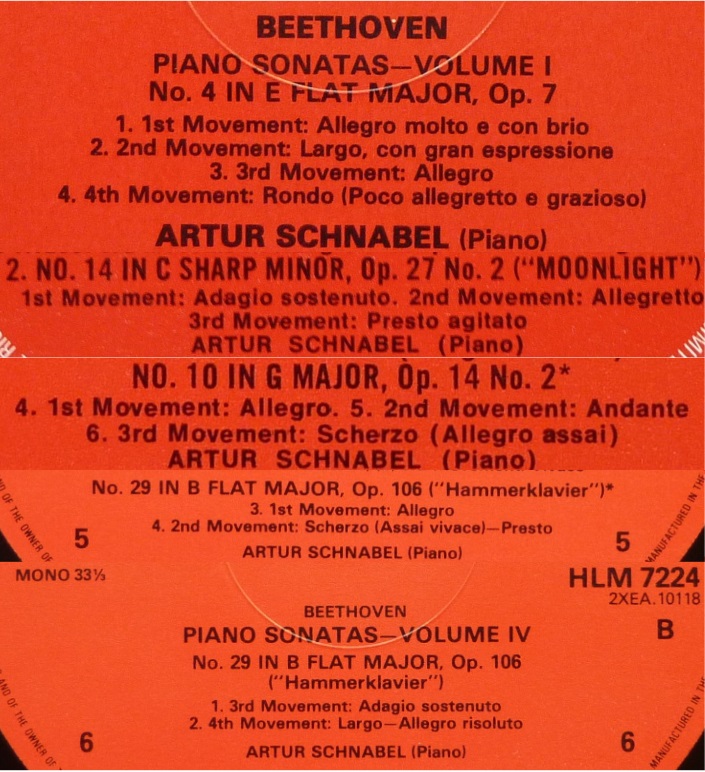
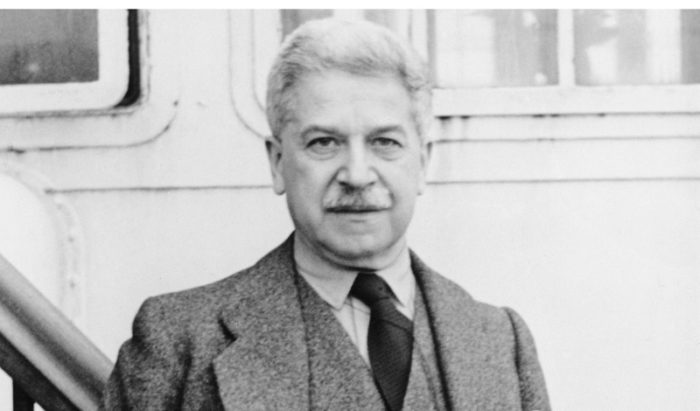
Sonate n°12 Op.26: 25-27 Avril & 4 Mai 1934
Sonate n°17 Op31 n°2: 27& 28 Avril 1934
Sonate n°5 Op.10 n°1: 6 Novembre 1935
Sonate n°6 Op.10 n°2: 10 Avril 1933
Sonate n°26 Op.81a: 13 Avril 1933
Artur Schnabel, piano
London Abbey Road Studio n°3 – Engineer: Edward Fowler – piano: Bechstein
Source: disques 33 tours « The HMV Treasury »
Le quatrième programme de l’intégrale des 32 sonates de Beethoven par Artur Schnabel comportait les cinq sonates mentionnées ci-dessus, dont les deux premières ont été jouées en première partie de concert.
Pour plus de détails sur les sept récitals de cette intégrale, cliquer ICI

Pour le quatrième programme de l’intégrale donnée par Schnabel à Carnegie Hall en 1936, Olin Downes souligne tout d’abord que le plus grand mérite de Schnabel est de démontrer une fois pour toutes au public de cette ville l’immense variété de contenu qui se trouve dans tout groupe de quatre ou cinq sonates de Beethoven, d’autant plus qu’il a la sagesse de les jouer, non par ordre chronologique, mais d’opposer des sonates de ‘styles’ et d »époques’ différentes d’une manière à la fois évocatrice et divertissante. » C’était également le cas hier soir, bien que Schnabel ait été d’humeur inégale. Dans la sonate en la mineur op.26 (n°12) qui ouvrait le programme avec un mouvement en variations, l’énoncé du thème était exagéré quant au style, le son était dur et l’interprétation était didactique et autoritaire. La sonate était au-delà du tempérament de l’exécutant, sans qu’on puisse du tout en déduire que Mr. Schnabel, en dépit de son objectivité et de son analyse, soit un interprète purement objectif. C’est même tout le contraire! Et il l’a prouvé dans l’interprétation suivante, celle de la sonate en ré mineur (n°17 Op.31 n°2) au dramatisme orageux, qui dans l’ensemble était la plus grande réussite de la soirée. Dans le premier mouvement qui pourrait bien porter comme spécifié pour d’autres sonates du compositeur, le sous-titre ‘quasi una fantasia’, il y avait du drame , presque du théâtre, sous sa forme la plus passionnée. Le chant dans l’Adagio, mouvement noblement proportionné, aurait pu être plus simple. Le Finale était puissamment conduit avec un sentiment romantique, et Mr. Schnabel a clairement montré que si ses motifs sont ostensiblement banaux, son expression est intense et agitée. Il s’est ensuite consacré à l’humour et à l’imagination de la sonate en do mineur Op.10 n°1 (n°5) ainsi qu’à une autre sonate, virile et joyeuse et elle aussi d’une veine plus légère, celle en fa majeur Op.10 n°2 (n°6) avec un ‘Scherzo’ (Allegretto) qui rappelle les hésitations du mouvement correspondant de la Cinquième Symphonie et son merveilleux trio. Les deux premiers mouvements, en particulier le deuxième étaient beethovéniens jusqu’à l’âme et si sans doute le Finale doit être très rapide, cela ne doit pas interférer avec la clarté comme cela a été le cas hier soir, où la clarté qui est une des vertus cardinales de Mr. Schnabel n’était pas toujours présente. Pour finir, c’était la sonate « Les Adieux » (n°26 Op.81a), « romantique » quant à son expression, mais dans une certaine mesure prophétique de développements modernes de la musique, et à cause de cela surestimée par ceux pour qui Beethoven ne saurait se tromper. Mais ici Mr. Schnabel est allé loin dans la révélation de la plénitude de la pensée de Beethoven, là où l’intuition ainsi qu’une profonde connaissance sont requises de l’exécutant. Le public a écouté avec dévotion et a tout applaudi frénétiquement ».
Le lendemain de ce concert, commençait au Metropolitan Opera le Cycle Wagner (6 février – 5 mars) donné chaque année avec le Ring et les Meistersinger dirigé par Artur Bodanzky et une distribution de rêve.
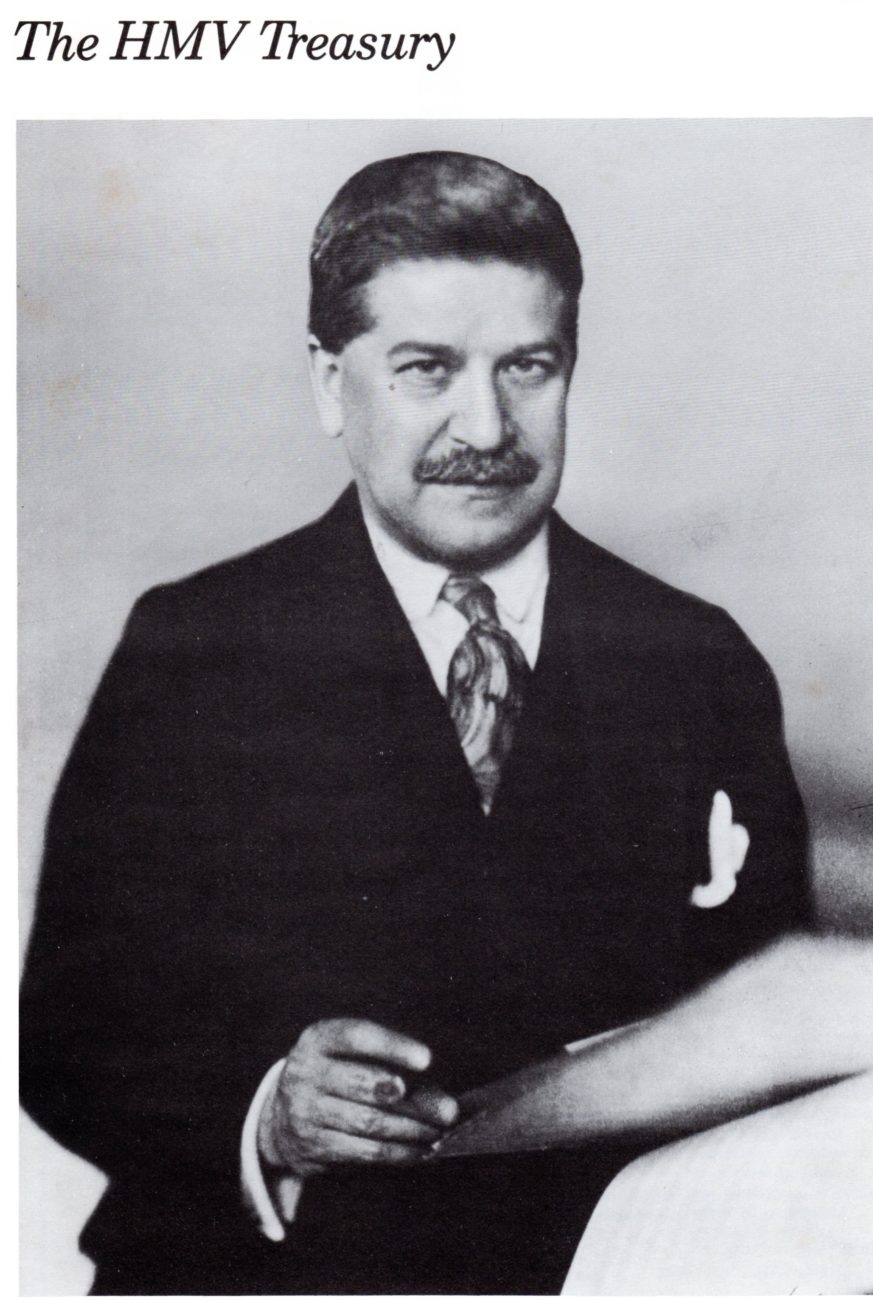
The fourth program of the complete performance of Beethoven’s 32 sonatas by Artur Schnabel was comprised of the five above mentioned sonatas, two of which being played before the intermission.
For a detailed description of the seven programs of his complete performances of Beethoven’s 32 sonatas, click HERE

For the fourth program of the complete performance given by Schnabel at Carnegie Hall in 1936, Olin Downes points out that, had Mr. Schnabel accomplished nothing else for the benefit of the public of this city, he would have demonstrated once and for all the immense variety of matter and of mood that any four or five of the thirty-two Beethoven sonatas contain. » He has had the wisdom, in program-making not to play these works in their historic sequence, but to contrast sonatas of different ‘periods’ and ‘styles’ in a way that is highly suggestive and entertaining… This was realized anew last night although Mr. Schnabel appeared to be in an uneven mood. He began with the A-flat sonata Op. 26 (n°12) which opens with variations. The announcement of the theme was exaggerated in style; tone most of the time was hard; there was a didactic and overbearing manner of interpretation.. The sonata apparently was outside the performer’s mood, and let no one think that Mr. Schnabel, for all his objectivity and analysis, is a purely objective player. Quite the contrary! He proved this in the performance that followed, which on the whole was the finest achievement of the evening. The sonata was the one in D minor (n°17 Op.31 n°2), stormily dramatic, a sonata which, like others so specified by the composer, could well bear the title in the first movement of ‘quasi una fantasia’. This was drama, almost theatre, of the most impassioned sort. The Adagio, nobly proportioned, could have been sung more simply. The Finale was given a powerful drive and again, dramatic feeling. Ostensibly trivial in its motives, it is actually a very expressive and agitated utterance, as Mr. Schnabel made clear. He turned then to the humor and fancy of the C minor sonata (n°5 Op.10 n°1) and to another sonata, virile, jocose, also in a prevailingly lighter vein, the one in F major Op.10 n°2 (n°6) with the ‘Scherzo’ (Allegretto) remindful of the gropings of the corresponding movement in the Fifth symphony, and the wonderful trio. The first two movements, especially the second, were Beethoven to the core. No doubt the finale should go very fast, but not so fast as to interfere with clearness, which was the case last night, when clearness, one of the cardinal attributes of Mr. Schnabel’s playing was not invariably in evidence. The end came with ‘Les Adieux’ sonata (n°26 Op.81a), ‘romantic’ in expression, prophetic in certain measures of modern musical developements, for all that a sonata overrated by those for whom Beethoven can do no wrong. But here, Mr. Schnabel went far to reveal the completeness of Beethoven’s meaning, in measures where divination as well as profound knowledge on the part of the performer is required. The audience listened devoutly. Everything that was done was rapturously applauded. »
The day after this concert, the annual matinee Wagner Cycle (February 6 – March 5) conducted by Artur Bodanzky began at the Metropolitan Opera with the Ring and Die Meistersinger and a dream cast.
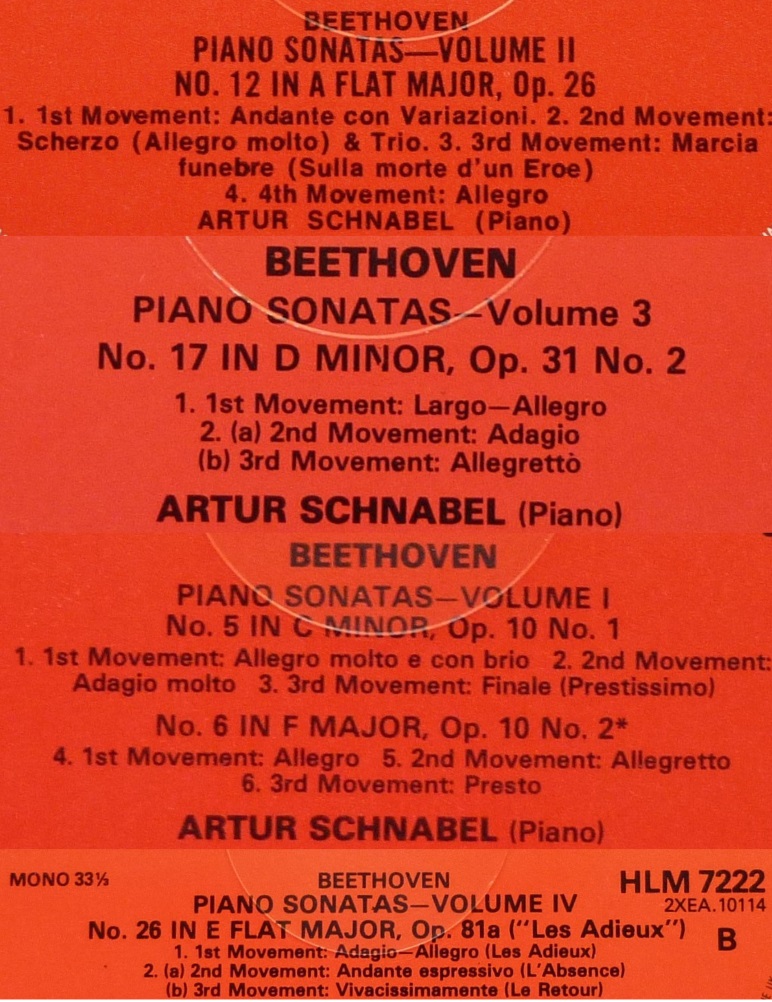

Sonate n°2 Op.2 n°2: 9 Avril 1933
Sonate n°23 Op.57: 11 Avril 1933
Sonate n°19 Op.49 n°1: 19 Novembre 1932
Sonate n°27 Op.90: 21 Janvier & 3 Février 1932
Sonate n°11 Op.22: 12 & 13 Avril 1933
Artur Schnabel, piano
London Abbey Road Studio n° 3 – Engineer: Edward Fowler – piano: Bechstein
Source: disques 33 tours « The HMV Treasury »
Le troisième programme de l’intégrale des 32 sonates de Beethoven par Artur Schnabel comportait les cinq sonates mentionnées ci-dessus, dont les deux premières ont été jouées en première partie de concert.
Pour plus de détails sur les sept récitals de cette intégrale, cliquer ICI

Pour le troisième programme de l’intégrale donnée par Schnabel à Carnegie Hall en 1936, Howard Taubman souligne que la simplicité et la ré-utilisation de moyens mis en oeuvre par d’autres compositeurs dans la sonate en la majeur Op.2 n°2 mettent en valeur l’audace et l’originalité de la pensée de Beethoven dans l’ « Appassionata » qui pour une fois n’est pas « interprétée », Schnabel semblant laisser Beethoven parler pour lui-même en libérant toute sa puissance, tout en maintenant l’oeuvre dans les limites du piano. « Il n’a pas donné l’impression que cultivent certains virtuoses qu’il pourrait obtenir on ne sait quels prodiges avec un instrument de plus grande ampleur. En jouant l’une après l’autre les sonates en sol mineur (Op.49 n°1) et en mi mineur (Op.90), Schnabel a montré qu’elles étaient plus proches que le simple fait d’avoir le même compositeur avec des ressemblances et des différences, la première étant calme, romantique et directe, et la deuxième, claire profonde et pénétrante. Et enfin, la sonate en si bémol majeur (Op.22), moins exigeante pour l’auditeur, terminait la courbe claire et ample du programme ».
Il est intéressant à ce point pour approfondir cette analyse du style d’interprétation d’Artur Schnabel par les critiques musicaux Olin Downes et Howard Taubman de se référer au magnifique texte de Claudio Arrau publié en 1952 sous le titre « Artur Schnabel Servant of the Music » (« Artur Schnabel Serviteur de la Musique ») et qui est pour l’essentiel consacré aux Sonates de Beethoven et à son message humaniste:
« Dans mon souvenir de la manière dont Schnabel jouait Beethoven, deux choses me viennent particulièrement en mémoire: sa compréhension du caractère global de chaque sonate et son traitement admirable des mouvements lents. Avec toutes les sonates, depuis la toute première—dans laquelle Beethoven est déjà Beethoven et aussi un maître, et qui de ce fait est entièrement achevée à la fois par sa forme et sa construction et par son caractère essentiel — jusqu’à l’ultime Op. 111, où Beethoven est le prophète qui transcende tout le combat humain, Schnabel est devenu lui-même un prophète par sa compréhension des détails des parties qui les constituent et de la somme totale de cette littérature colossale.
A une époque où jouer vite semblait souvent être le seul but de la virtuosité pianistique, Schnabel n’en avait cure et il montrait son courage en jouant vraiment lentement les mouvements lents. Renforcé par sa conviction et par sa concentration, il les jouait plus lentement que quiconque ne l’avait jamais imaginé possible. Et sa manière de ralentir encore plus à la fin de tels mouvements était absolument inoubliable, un ralentissement qui créait une atmosphère dramatique et une tension qui étaient à la fois impressionnantes et uniques. C’était la preuve d’un profond calme intérieur que la plupart des musiciens n’atteignent que tard dans leur vie, voire jamais, mais qu’il possédait à un rare degré depuis le début. . . .
Son interprétation de l’Opus 54 (sonate n°22) montre qu’il ne suivait pas aveuglément sa propre édition et ses indications, mais se donnait la liberté de suivre l’inspiration du moment. Il maintenait à un rare degré à la fois un équilibre des moyens pour faire les choses comme il les concevait et un équilibre entre l’intellect et l’émotion intuitive. Beaucoup d’artistes ont soit l’un, soit l’autre de ces dons. Mais chez Schnabel il y avait une synthèse remarquable de savoir, d’intelligence, d’intuition, d’émotion et de moyens techniques. L’importance en tant qu’artiste de Schnabel vient de l’importance du message de la musique de Beethoven. Avec les trente deux sonates, Beethoven a créé tout un univers. Dans leur globalité, elles forment une immense épopée du combat de l’humanité et de sa souffrance et de la victoire ultime de l’esprit. Fait unique, Schnabel était un homme et un artiste à la hauteur de toutes les exigences de cette stupéfiante effusion de génie.
Dans les dernières sonates, Beethoven a développé un langage pour les initiés, un langage dont le caractère symbolique et ésotérique n’a jamais été surpassé dans aucune autre œuvre d’art antérieure ou postérieure. C’est parce que Schnabel était un des rares initiés qui comprenaient et parlaient ce langage qu’il était capable de rendre le Beethoven de cette période plus proche de la compréhension contemporaine. Il n’y a pas de plus grande réalisation qu’un artiste puisse accomplir. »
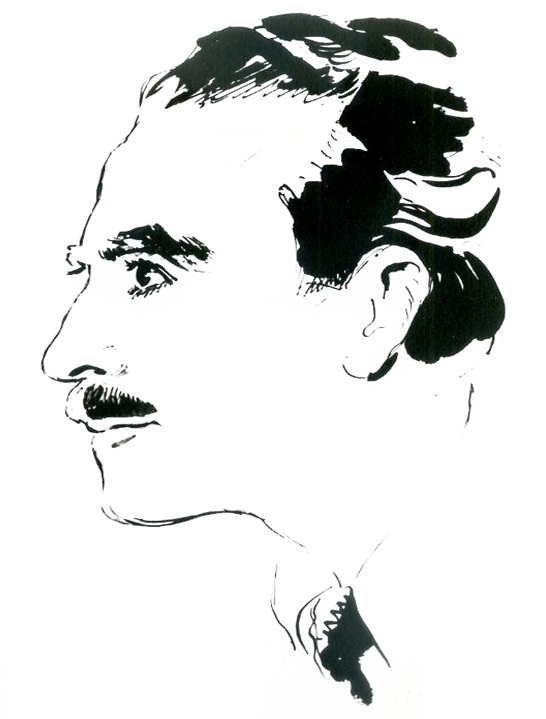
Claudio Arrau
____________
Artur Schnabel’s third program of the complete Beethoven sonatas was comprised of the above mentioned five sonates, two of which being played before the intermission.
For a detailed description of the seven programs of his complete performances of Beethoven’s 32 sonatas, click HERE

For the third program of the complete performance given by Schnabel at Carnegie Hall in 1936, Howard Taubman underlines that the simplicity and untroubled iteration of other composer’s devices of the early sonata from the Op.2 series (Op.2 N°2) were ideal foils for the audacity and originality of Beethoven’s thinking in the « Appassionata » for which Mr. Schnabel seemed to let Beethoven speak for himself with all its surging power, while keeping the work within the piano’s limitations. « He did not give the impressions cultivated by some virtuosos what wonders they could work with an instrument with greater scope. The G minor (Op.49 n°1) and E minor (Op.90) sonatas placed besides each other, appear to have a closer relationship than the obvious one of stemming from the same progenitor. Mr. Schnabel indicated their closeness and disparity – the former: cool, romantic, direct; the latter: clear, profound, penetrating. And finally the B flat major sonata (Op.22), less exacting in its demand on the listener and providing the end of the program’s clean, sweeping curve ».
It is interesting at this point to deepen this analysis of Artur Schnabel’s style by music critics Olin Downes and Howard Taubman, to revert to the magnificent text by Claudio Arrau published in 1952 under the title « Artur Schnabel Servant of the Music » and essentially dealing with the Beethoven Sonatas and their humanist message:
« Remembering how Schnabel played Beethoven, two things particularly stand out in memory: his grasp of the whole character of every sonata and his divine way with the slow movements. With all the sonatas, from the very first one—in which Beethoven is already Beethoven and a master, and which is therefore entirely definite both in shape and construction and in essential character—to the final Op. 111, where Beethoven is the seer transcending all human struggle, Schnabel became a seer himself in his grasp of the component details and the sum total of this colossal literature.
In a period when playing fast often seemed to be the sole goal of piano virtuosity, Schnabel paid no heed and showed his courage by making the slow movements really slow. Strengthened by conviction and concentration, he played them slower than anyone else had even imagined to be possible. Absolutely unforgettable was his way of slowing down still more at the end of such movements, a slowing-down that created a dramatic atmosphere and tension that were both impressive and unique. This was evidence of a deep, inner repose that most musicians attain only latc in life, if ever, but that he possessed to a rare degree from the beginning. . . .
His performance of Opus 54 shows that he did not follow his own edition and markings slavishly, but gave himself freedom to follow the inspiration of the moment. To a rare degree he maintained both a balance of the means required to do things as he conceived them and a balance between intellect and intuitive emotion. Many artists have one gift or the other. But in Schnabel there was a remarkable synthesis of knowledge, intelligence, intuition,emotion and technical means. Schnabel’s importance as an artist stems from the importance of the message of Beethoven’s music. In the thirty-two sonatas Beethoven created a whole cosmos. In their totality, they form an immense epic of man’s struggle and suffering and ultimate victory of the spirit. Schnabel, uniquely, was man and artist enough to meet all the demands of this staggering outpouring of genius.
In these last sonatas Beethoven developed a language for the initiated, a language of a symbolic and esoteric character never more strongly pronounced in any works of art before or since. Because Schnabel was one of the few initiated who understood and spoke this language he was able to bring the Beethoven of this period nearer to contemporary comprehension. No greater realization could come to any artist. »
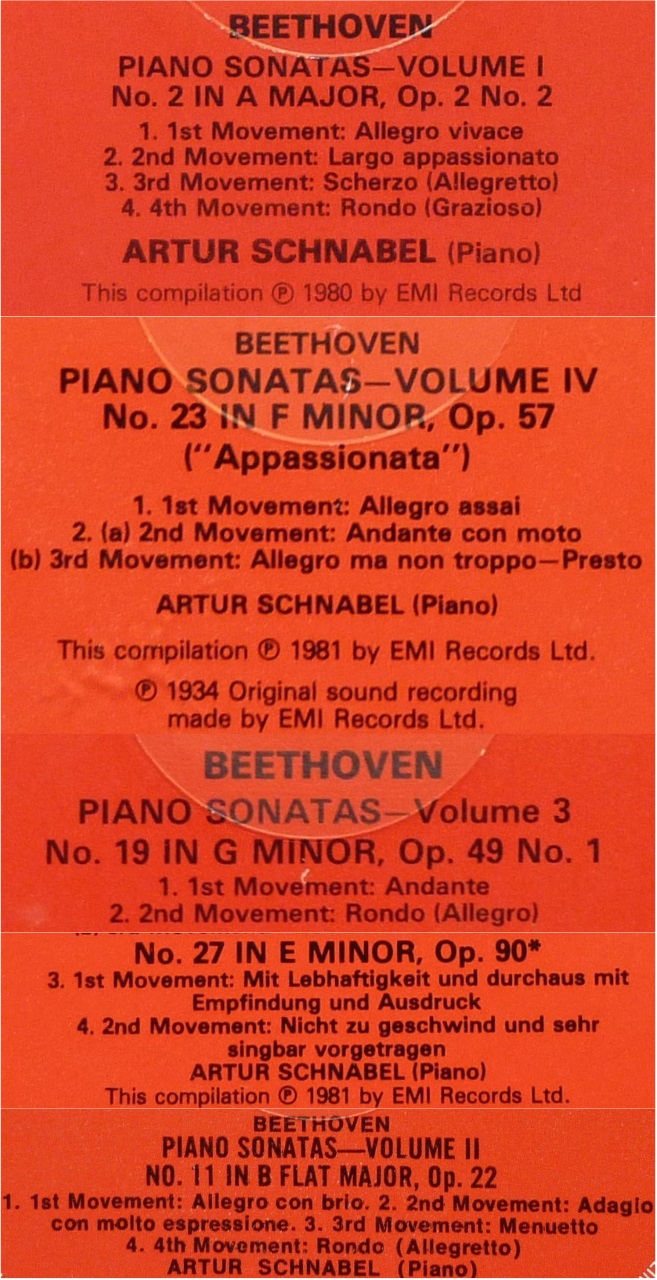

Sonate n°18 Op.31 n°3: 25 Mars 1932
Sonate n°28 Op.101: 24 Avril 1934
Sonate n°22 Op.54: 11 Avril 1933
Sonate n°8 Op.13: 2 Octobre 1933; 23 Avril 1934
Sonate n°3 Op.2 n°3: 26&27 Avril 1934
Artur Schnabel, piano
London Abbey Road Studio n° 3 – Engineer: Edward Fowler – piano: Bechstein
Source: disques 33 tours « The HMV Treasury »
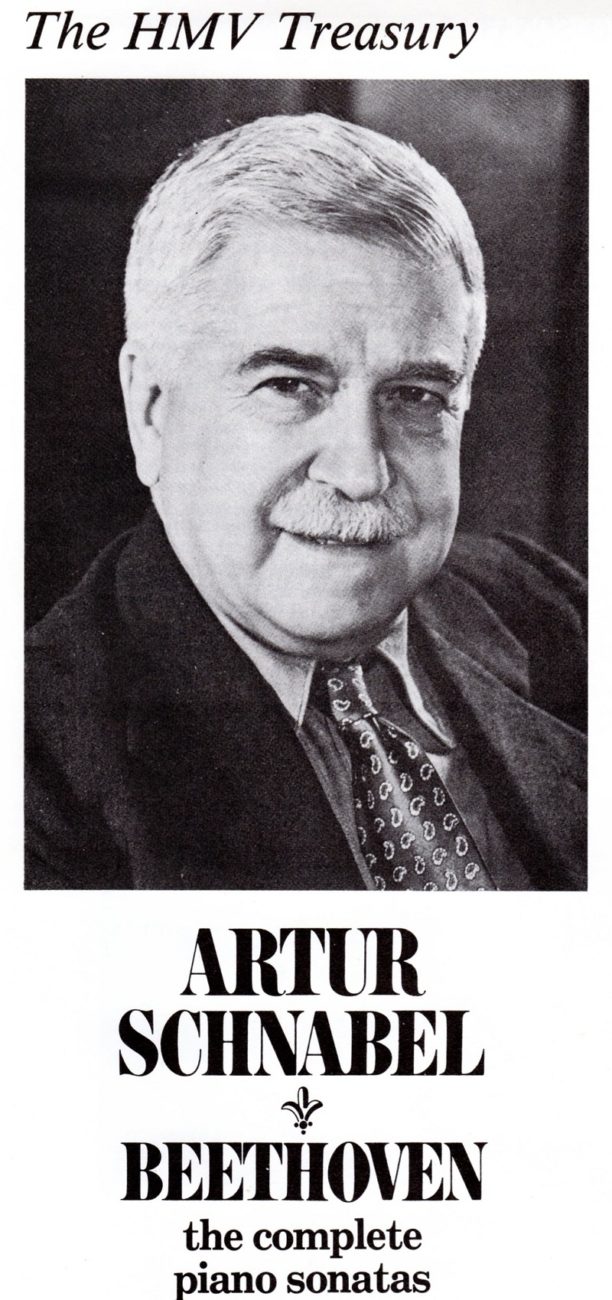

Le deuxième programme de l’intégrale des 32 sonates de Beethoven par Artur Schnabel comportait les cinq sonates ci-dessus, dont les deux premières ont été jouées en première partie de concert.
Pour plus de détails sur les sept récitals de cette intégrale, cliquer ICI
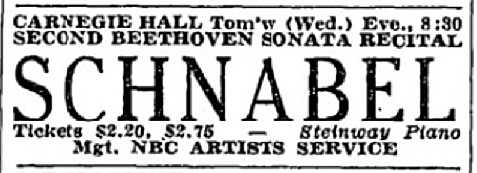
Pour le deuxième concert (22 janvier) de l’intégrale donnée à Carnegie Hall en 1936, nous disposons de la critique d’Howard Taubman qui va pour l’essentiel dans le même sens que son confrère Olin Downes: Il souligne tout d’abord à quel point l’oreille était réjouie par une richesse de phrasés, de nuances et de dynamique tout le long de chaque œuvre, que cependant l’auditeur n’avait jamais son attention détournée par des fragments, mais qu’il était conduit à voir toute la logique de chaque composition. Il note également que la réussite de ce récital ne pouvait que rendre difficile de soutenir l’objection de certains que les interprétations de Schnabel seraient trop intellectuelles, et que l’émotion en serait évacuée par la prééminence de la tête sur le cœur, car il à joué avec brillance et tempérament. Et que si le pianiste ne laissait pas libre cours à son tempérament, c’était pour de bonnes raisons.
« La sonate dite « Pathétique » (n°8 Op.13) a été jouée avec incandescence, sans qu’elle puisse virer à la sentimentalité. La sonate en mi bémol majeur (n°18 Op.31 n°3) était vibrante, et pleine de brio. Et pour une pleine compréhension de la profondeur de l’imagination de M. Schnabel, il faut mentionner la grandeur et la noblesse de son jeu dans l’Op.101 (n°28). Le public a une nouvelle fois écouté dans un silence qu’on ne rencontre que lors d’événements rituels comme le cycle Wagner en matinée au Metropolitan. »
Artur Schnabel’s second program of the complete Beethoven sonatas was comprised of the above mentioned five sonates, two of which being played before the intermission.
For a detailed description of the seven programs of his complete performances of Beethoven’s 32 sonatas, click HERE

For the second concert (22 January) of the complete performance of the 32 Sonatas given at Carnegie Hall in 1936, we have an article by Howard Taubman who basically shares the view of his associate Olin Downes: He underlines in the first place that the ear caught innumerable felicities of phrase, nuance and dynamics, as a work pursued its course and that the auditor nevertheless was never deterred by fragments, but compelled to see the complete logic of each composition. Objecting to his interpretations on the ground that they are intellectualized and that the emotion is wrung out by the predominence of the head over the heart is a thesis difficult to defend in the face of last night’s accomplishment. For Mr. Schnabel played with brilliance and temperament. True, his temperament was held in leash, and with good reasons.
« The sonata known as the « Pathétique » (n°8 Op.13) was played with enkindling warmth but it was not permitted to deteriorate into sentimentality. The E flat major sonata (n°18 Op.31 n°3) was vibrant, full of gusto. For a full comprehension of the profundity of Mr. Schnabel’s imagination, one must speak of the grandeur and nobility of his playing of Op.101 (n°28). The audience again observed the hushed attention that is only perceptible at ritual events like the Wagner matinee cycle at the Metropolitan. »

Sonate n° 15 Op.28: 3 & 17 Février 1933
Sonate n°31 Op.110: 21 Janvier 1932 (premier enregistrement de Schnabel)
Sonate n°1 Op.2 n°1: 23, 24 & 28 Avril 1934
Sonate n°16 Op.31 n°1: 5 & 6 Novembre 1935; 15 Janvier 1937 (face 4)
Artur Schnabel, piano
London Abbey Road Studio n° 3 – Engineer: Edward Fowler – piano: Bechstein
Source: disques 33 tours « The HMV Treasury »
Artur Schnabel a non seulement enregistré entre 1932 et 1935 la toute première intégrale des 32 Sonates pour piano de Beethoven, mais, à quatre reprises, il les a aussi jouées au concert à Berlin en janvier-février 1927, à Londres en octobre-novembre 1932, de nouveau à Berlin en janvier-avril 1933 et enfin à New York en janvier-février 1936, sous forme de cycles de sept récitals toujours composés de la même façon, chaque récital panachant soit quatre, soit cinq, sonates de différentes périodes. Pour plus de détails, cliquer ICI
Nous vous proposons d’écouter son intégrale enregistrée en reprenant le programme de chacun de ces sept récitals.
Pour le premier de ces programmes, nous disposons d’une critique tout à fait remarquable, un modèle du genre, écrite par Olin Downes après le récital à Carnegie Hall du 15 janvier 1936:
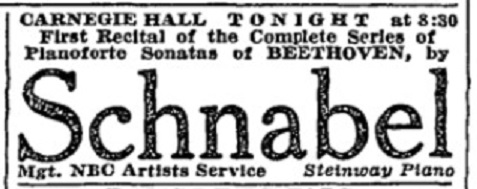
Downes mentionne tout d’abord que le public était composé en majorité de musiciens, d’étudiants et de mélomanes avertis et que de nombreux spectateurs suivaient attentivement sur la partition. Concernant le pianiste, il mentionne son sens de la grande ligne mais aussi du moindre détail, ainsi que la perfection des proportions, la profondeur de pensée et l’authenticité des sentiments qu’il projette, et enfin la simplicité sans ostentation de sa tenue en scène.
Il souligne que la musique est projetée avec une extraordinaire signification, car chaque sonate, qui est un monde en soi, est traitée comme telle en fonction de la nature de la musique et de la période qu’elle représente dans l’évolution de la pensée Beethoven. Et que cette communication s’établit sans que Schnabel ait jamais besoin « d’élever la voix du piano », car le timbre du piano et la pensée musicale se projettent dans le vaste espace de Carnegie Hall, grâce à une gamme de nuances très finement ajustée. Il note un remarquable degré de différentiation entre des accords « mezzo-piano » et « piano », entre le niveau dynamique de chaque note d’une courte phrase expressive ainsi que des gradations de tempo tout aussi subtiles, comme lors de la dernière apparition du thème dans le mouvement lent de la sonate dite « Pastorale » (n°15 Op.28).
Il note aussi l’objectivité de Schnabel, comme s’il nous disait: « Voici une sonate de Beethoven, et pour autant que j’aie pu le découvrir au cours d’une vie d’étude, c’est comme ceci que Beethoven voulait qu’elle sonne. Je le tiens de la partition de Beethoven que j’ai examinée dans toutes les versions, manuscrites et imprimées et dont ma propre édition énonce mes conclusions« . Ce que décrit ainsi Downes, c’est la filiation de Schnabel, qui composait de la musique atonale, non avec le romantisme, mais avec Arnold Schoenberg.
Concernant le programme joué ce soir là, Downes note de nouveau que chaque sonate y avait son propre style, et que la tranquillité de la sonate n°15 Op.28 qui ouvrait le concert constituait un prélude particulièrement approprié à la rhapsodie démoniaque et mystique de l’Op.110 (n°31), peut-être la plus mystérieuse de tout le cycle, dans laquelle Beethoven rêvait des rêves et avait des visions.
« Quant à la sonate n°1 Op.2 n°1, elle a été jouée avec la pleine prémonition de son caractère prophétique, mais sans exagération. Le mouvement lent a été chanté avec un parfait cantabile et un legato qu’on n’imaginerait pas au clavecin, mais avec une grâce mozartienne et une simplicité dans l’accentuation. Le Finale était plus qu’une prémonition du Beethoven en devenir, et du développement du mouvement romantique de la musique pour piano. Chaque sonate a été saluée par de longs applaudissements. »
La réédition de ces enregistrements a toujours été problématique en raison de l’adoption systématique par les éditeurs d’un filtrage du bruit de fond des 78 tours, qui se fait toujours aux dépens de la musicalité (nuances, phrasés, timbres et dynamique). Toutefois, en 1980/81, à l’occasion du Centenaire de la naissance de Schnabel, une série d’albums 33 tours sous le label « The HMV Treasury » a remarquablement restitué ces interprétations à partir de nouveaux reports effectués par Keith Hardwick dans les Studios d’Abbey Road à partir de pressages vinyle des matrices métalliques d’origine, dépourvus des bruits de surface des disques 78 tours commerciaux. Les éditions successives en CD (EMI et Warner) ont été décevantes à cause de l’usage systématique d‘un filtrage excessif. D’autres éditeurs (Pearl, Naxos) ont obtenu de meilleurs résultats à partir de 78 tours commerciaux, sans toutefois égaler les Albums « The HMV Treasury ».
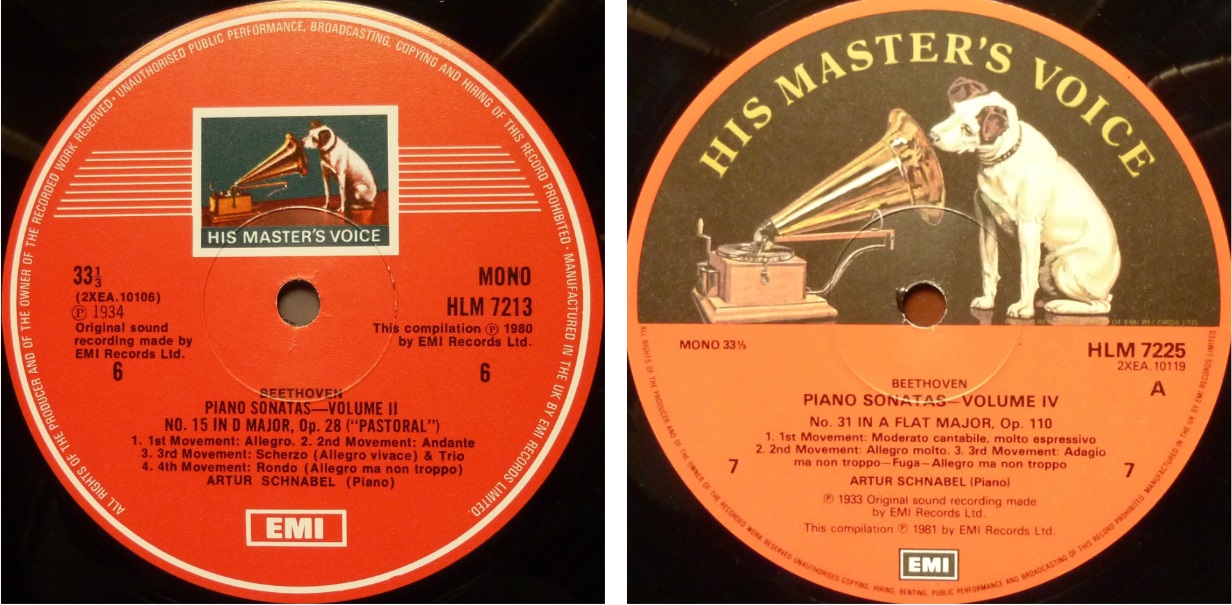
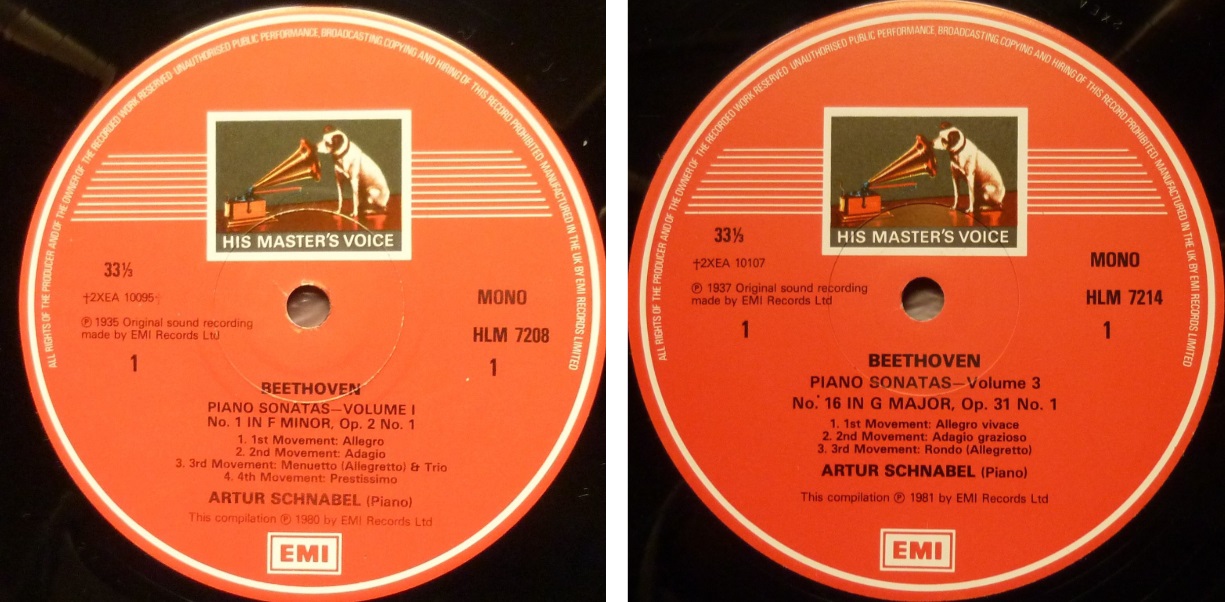
____________
Sonata n° 15 Op.28: 3 & 17 February 1933
Sonata n°31 Op.110: 21 January 1932 ( Schnabel’s first recording)
Sonata n°1 Op.2 n°1: 23, 24 & 28 April 1934
Sonata n°16 Op.31 n°1: 5 & 6 November 1935; 15 January 1937 (side 4)
London Abbey Road Studio n° 3 – Engineer: Edward Fowler – piano Bechstein
Source: LPs « The HMV Treasury »
Artur Schnabel has not only made between 1932 and 1935 the very first complete recording of the 32 piano Sonatas, but he also performed them four times during concert cycles in Berlin in January-February 1927, in London in October-November 1932, again in Berlin in January-April 1933 and lastly in New York in January-February 1936, each cycle of seven recitals always organized in the same way, each recital being comprised of either four or five Sonatas from different periods. For a detailed description, click HERE
We propose you to listen to his complete recording according to the program of each of these seven recitals.
For the first of these programs, we have an outstanding article, indeed a model, written by Olin Downes after the Carnegie Hall recital of 15 January 1936:

To start with, Downes mentions that the majority of the public consisted of musicians, students and serious music lovers and that a great many in the audience had scores to follow every note of the interpretations. As to the pianist, he notes his sense of the grand line and of the most significant finish of detail, as well as the perfect proportion, the depth of thought and the genuineness of feeling he conveys, but also his unostentasious manner and his simplicity on the platform.
He underlines that the music is projected with extraordinary significance. As each sonata is a different world in itself, so does the treatment of each one vary in accordance with the nature of the music and the period that it represents in Beethoven’s thought. And he establishes this communication never by « raising the piano’s voice », because the tone carries and the musical thought carries in the wide spaces of Carnegie Hall, and this by means of a very finely adjusted scale of values. He notes a remarkable degree of difference between chords « mezzo-piano » and « piano », between the dynamic value of each note of a short expressive phrase, as well as equally subtle gradations of tempo, witness the last appearance of the theme of the slow movement of the so-called « Pastoral »sonata (n°15 Op.28).
He also notes Schnabel’s objective vein, seeming to say: « This is Beethoven‘s sonata, so far as I have been able to discover in a lifetime of study, it is precisely as Beethoven wanted it to sound. My authority is Beethoven’s score which I have examined in all the existing manuscript and printed versions of which my own edition states my conclusions« . What Downes thus describes is the direct line of Schnabel, who composed atonal music, not with romantiscm, but with Arnold Schoenberg.
As to the program performed that evening, Downes notes again that each sonata had its special style, and that the tranquillity of sonata n°15 Op.28 that opened the concert made a particularly felicitious prelude to the demoniac and mystical rhapsody of the Op.110 (n°31), perhaps the most mysterious of the whole set, wherein Beethoven dreamed dreams and had visions.
« The sonata n°1 Op.2 n°1 was performed with the fullest realization of its prophetic character, but without forcing this note. The slow movement was sung with an immaculate cantilena and a legato that it would be hard to conceive as issuing from the harpsichord, yet with a Mozartian grace and simplicity of accent. The Finale was more than a premonition of the Beethoven to come, and indeed of the course of the romantic movement in piano music. There was long applause after each sonata. »
The reissue of these recordings was always problematic because of the systematic use by the editors of noise reduction to filter the background noise of the 78rpm, always detrimental to musicality (details, phrasings, timbres and dynamics). However, in 1980/81, with a view to celebrating the Centenary of Schnabel’s birth, a series of LP Albums under the label « The HMV Treasury » has remarkably restored these performances from fresh transfers made by Keith Hardwick at the Abbey Road Studios from vinyl pressings of the original metal parts, devoid of the background noise of the commercial shellack 78rpm. The later CD issues (EMI et Warner) were a failure because of the systematic use of excessive filtering. Other firms (Pearl, Naxos) obtained better results from commercial shellack pressings, without however matching the « The HMV Treasury » Albums.



